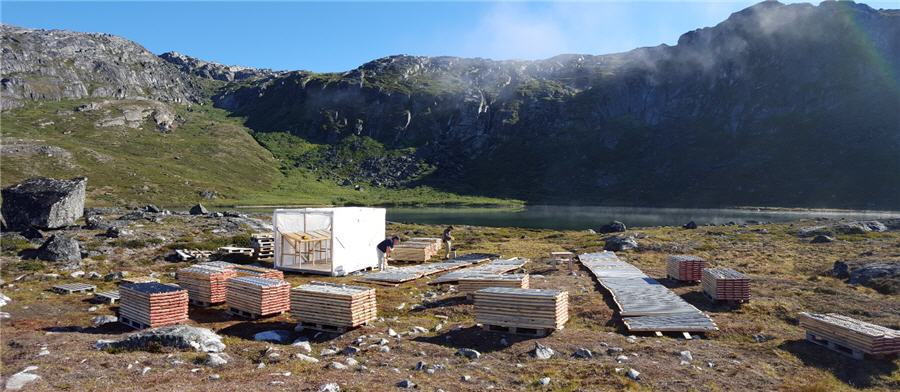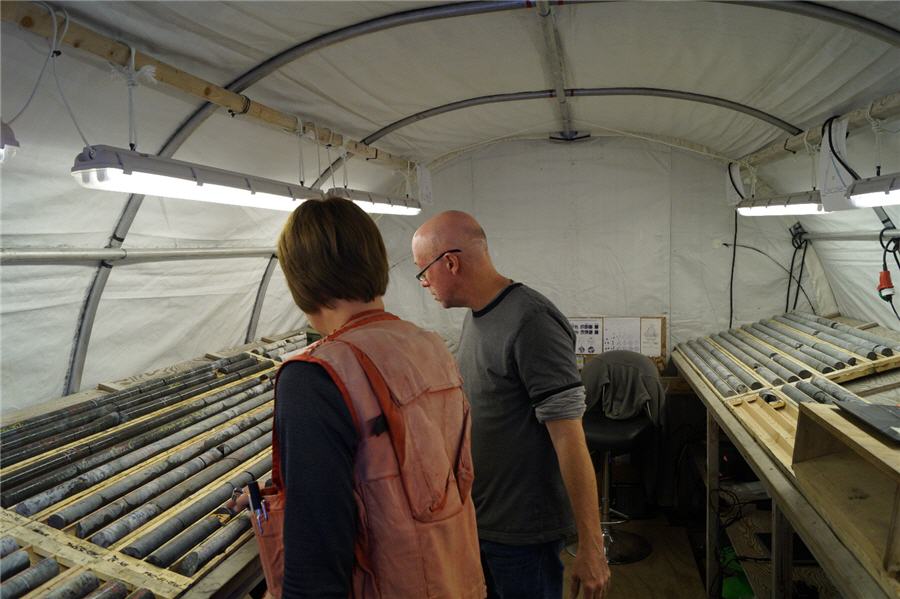
Investors in North American Nickel (TSXV:NAN) have waited patiently while the Vancouver-based company has made consistent and significant progress on its 100%-owned Maniitsoq nickel sulphide project. Will their loyalty be rewarded? The answer will soon be revealed, with first results from its drill program due out within a month.
The main objective of the 11,000-metre program is to do step-out drilling at three targets previously identified at Maniitsoq, NAN’s flagship property located in southwest Greenland. According to a press release,
The three areas selected for drilling in 2017 are a culmination of the exploration work carried out in 2015 and 2016. Fossilik and the Imiak Hill Complex (IHC) each represent areas where one or more discrete and open sulphide lenses and multiple untested exploration targets have been defined. P-013 SE represents a new discovery of high grade nickel sulphide mineralization which has only been tested with one drill hole to date. In particular, step-out drilling will be carried out to follow-up significant sulphide mineralization intersected in 2016 at the following zones:
P-058 (Fossilik)
MQ-16-105: 10.20 metres of 3.41% Ni, 0.28% Cu, 0.10% Co and 0.13 g/t Pt+Pd+Au
P-013 SE
MQ-16-109: 13.35 metres of 2.88% Ni, 0.80% Cu, 0.06% Co and 0.46 g/t Pt+Pd+Au
Mikissoq (IHC)
MQ-16-117: 74.05 metres of 1.08% Ni, 0.54% Cu, 0.03% Co and 0.11 g/t Pt+Pd+Au
Spotty Hill (IHC)
MQ-16-121: 4.75 metres of 1.59% Ni, 0.30% Cu, 0.04% Co and 0.66 g/t Pt+Pd+Au
The 2017 program – which includes diamond drilling, borehole electromagnetic (BHEM) surveys, surface Induced Polarization (“IP”) geophysical surveys, mapping, prospecting, sampling, structural geological studies and 3D modeling – is in the third year of a three-year exploration program. The 90-day field program will test drill targets of merit from 2016 that have displayed continuity among multiple mineralized zones across the district-scale property containing nickel, copper, cobalt and platinum group metals (PGMs).
“The results from the 2016 drilling campaign were successful in allowing NAN to progress to this next stage of follow-up drilling to continue to evaluate size potential at Maniitsoq. The goal of the 2017 work program is to advance the project to a delineation and resource estimate stage by 2018 and to continue to lay the ground work for critical infrastructure needed for future resource development,” NAN CEO Keith Morrison said in announcing the start of the program in June. 2017 drilling is expected to wrap up in late September.
To understand how far North American Nickel has come towards its objective of announcing a maiden resource on the sprawling 2,985-square-kilometre property – much of it encompassing the 15- by 75-kilometre Greenland Norite Belt – one has to go back to 2015, when NAN shifted its exploration strategy after encountering a challenge the year earlier at its most promising target, Imiak Hill.
A VTEM geophysical survey had shown a strong anomaly there with drill results indicating upwards of 2% nickel. The company thought it continued at depth but when it kept drilling it hit an unmineralized shear zone which spooked the market, causing downward pressure on the stock price.
“That precipitated a re-look at the property to see what other showings are prospective. There are many others. That year [2015] we spent quite a bit of money collecting data, including more VTEM surveying, looked at the chemistry of intrusions and drilled a lot of regional targets to understand which of many intrusions were prospective,” says Patti Tirschmann, North American Nickel’s VP Exploration. The veteran geologist with 25 years experience specializes in magmatic nickel-copper sulphide deposits like Maniitsoq.
Geologically, she said the property has all the elements necessary for an economic nickel sulphide deposit, including a large scale “magmatic event” that formed the Greenland Norite Belt about 3 billion years ago, comprising numerous mafic and ultramafic intrusions over a 70 kilometre strike extent, and evidence that the magmas have precipitated sulphides – in this case the main nickel-bearing mineral pentlandite, which supports high nickel recoveries using conventional metallurgical processes.
“It’s one of the only properties I’ve seen that has this much widespread nickel mineralization with this many intersections that I would consider to be very good,” says Tirschmann, referring to grades above 1% nickel over between 5 and 20 metres. (a grade of greater than 1% over multiple metres is considered a good sulphide nickel intersection) “That is really anomalous to see outside of a producing nickel belt.”
The 2015 exploration program included 30 holes of diamond drilling (5,655m), a nearly 7,000 line kilometre geophysical survey by helicopter, 62 line km of surface electromagnetic surveying and the acquisition of state-of-the-art Worlview-3 spectral satellite data across the entire property. The surveys helped NAN to better target mineralization and to vastly improve on the level of mapping detail.
Highlights of the $8.3 million program included the expansion of the Spotty Hill zone and significant drill intersections at six Ni-Cu sulphide occurrences including 1.98% Ni and 0.62% Cu over 23.7 metres at regional target P-053.
In 2016 the company zeroed in on about 10 occurrences – some historical, some new – and continued drilling those zones. It also introduced an additional geophysical method, Induced Polarization (IP) surveying to augment the electromagnetic (EM) surveys and more fully define the overall footprint of mineralized zones. Tirschmann explains:
“EM methods are critical to nickel sulphide exploration. What you really want is to do a survey and identify one large continuous EM anomaly. Unfortunately when you’re in high deformation terrane (the rocks are deformed, meaning folded and faulted) your sulphides can be just broken up enough to lose electrical connectivity. In our environment instead of large EM plates you see clusters of small EM plates. That makes it harder to target them. When you drill them you get good intersections and around them you get a halo of disseminated or less connected sulphides. There’s no way with EM methods to image that wider halo. So that’s why we brought in IP surveys – to target a larger footprint of the mineralization.”
While it’s still early to know what that means for mining, Tirschmann said any future resource would likely be mined using a combination of open-pit and underground methods. “It’s almost that certain that on this property it would be a combination of the two,” she says. “You have a number of near-surface showings that already present themselves as pits but as you follow those mineralized systems down you’ll eventually get to the point where you need to switch over to underground mining methods.”

Picture within original NAN Investor Bulletin.
Of course, NAN will have to walk before it can run, and the next step for the company is clearly to identify a maiden resource that is NI 43-101-compliant.
Tirschmann said the process since 2015 has really been to “open up the tool box” to try to understand the structural setting. “Now we’re drill testing, we’re refining our drill targeting and we’re hoping to get to the chase quicker.”
She pointed out that a big challenge with Maniitsoq is logistics. The property has no roads so all equipment must be barged in from the capital Nook to the exploration camp, situated on a fjord. From there it is mobilized by helicopter to drilling areas 8 to 40 km inland. Compare that to exploration in established nickel districts in Canada – such as Thompson and Sudbury – where access roads and other infrastructure exists. The current dependency on helicopter support translates into a shorter drilling season – typically three to four months versus year round in other jurisdictions.
Then there’s the size of the property and the nature of the mineralization. The huge expanse of Maniitsoq with its large number of Ni-Cu occurrences and the complex structural history and disrupted nature of the sulphides all present big challenges for just one junior.
“We have spent a couple full years in total on a belt the size of Sudbury, that’s been looked at for over 100 years, and we’re doing it as one little junior exploration company versus 10 or 20 that you’d typically have on a belt this size if it wasn’t so remote,” says Tirschmann.
Still, the company has made great strides and if it can deliver on its 2017 exploration objectives, the market will take notice. North American Nickel has budgeted about $12 million for the program and with the program well underway and $9.6 million in the treasury it should have no trouble executing that. In June NAN closed a $10.8 million equity financing and in August raised just over $3 million through a private placement.
“This year is quite an important year for us,” says Tirschmann. We need to understand if any one of our chosen areas represent that centre of gravity,” she said, referring to the ability to define a maiden resource that could take the project to the next level, including attracting more anchor investors and interest from government entities that could assist in building out infrastructure like roads and power.
The timing could be good as far as the nickel market. While nickel prices over the past few years have struggled due to oversupply, this year prices picked up, even nearing US$12,000 a tonne mainly due to a resurgence in Chinese steel production and the spectre of nickel smelter closures in Indonesia and nickel mines in the Philippines, both major nickel producers.
According to a July report by Wood Mackenzie, lower output from Vale, the world’s largest nickel producer, could contribute to mounting annual nickel deficits, resulting in nickel prices moving up in 2018 and 2019.
“The more substantial shortfall in 2019 together with an outlook of sustained under supply in subsequent years, and declining stocks, will push nickel prices higher in 2019,” reads the report. “We project prices exceeding US$11,000/t (US$5.00/lb) in the first half of the year and then building towards US$13,000/t (US$5.90/lb) by year-end. This gives a forecast average for the year of approximately US$10,775/t (US$4.90/lb), which is 9% up on 2018.”
The consulting firm adds that it expects demand in 2019 to pick up due to increased output of high-nickel stainless at Baosteel Desheng in China – a major stainless steel producer.